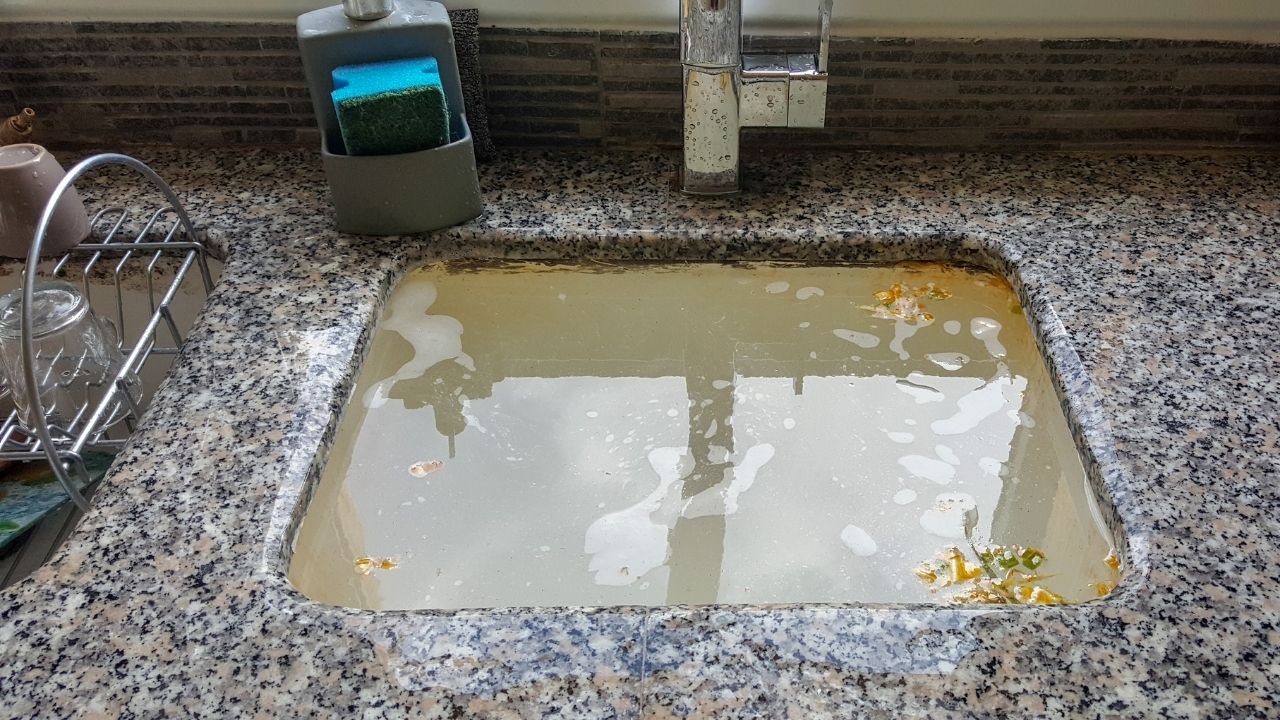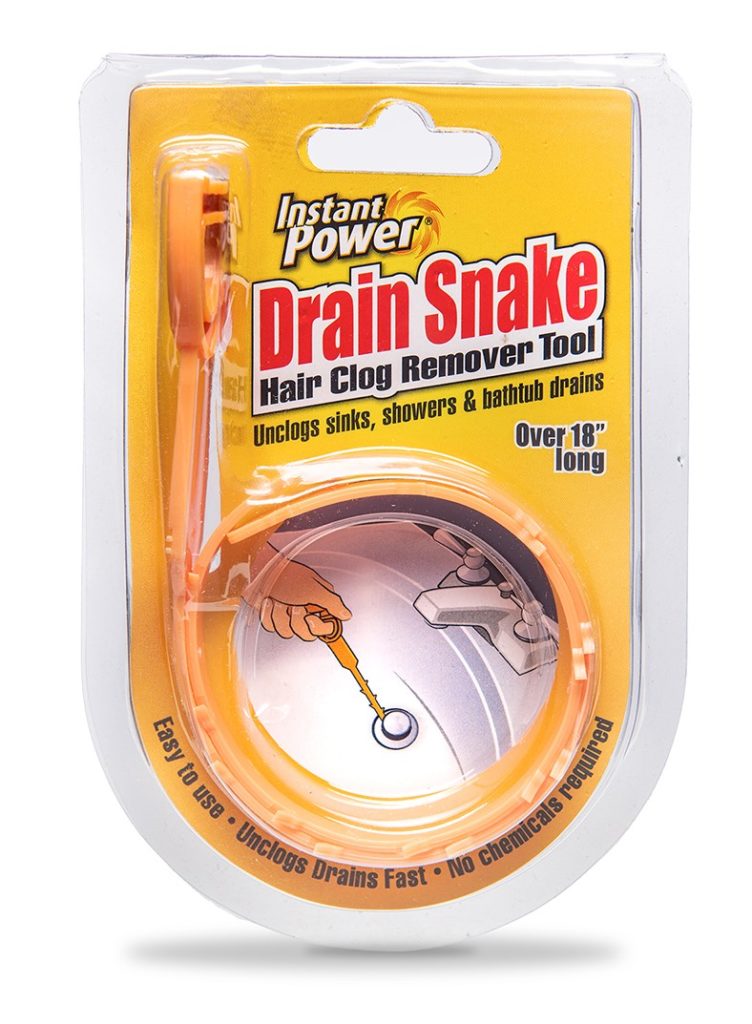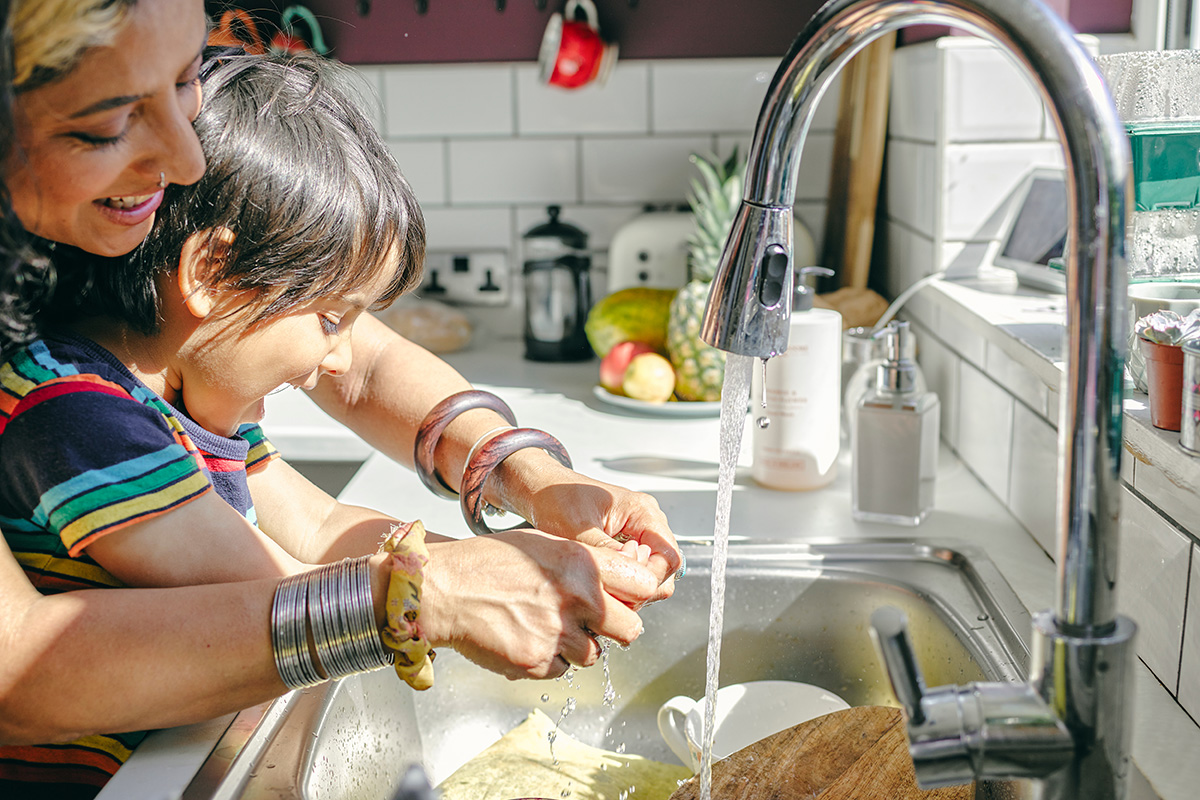Unclog a Kitchen Sink
If you're facing the frustrating issue of a slow-draining kitchen sink, don't panic. There are several simple and effective methods to unclog your kitchen sink and get the water flowing smoothly again. Whether it's from a buildup of food particles, grease, or other debris, a clogged kitchen sink can be a nuisance. But with the right tools and techniques, you can easily fix the problem yourself without having to call a plumber.
How to Fix a Slow-Draining Kitchen Sink
Before you start trying to unclog your kitchen sink, it's important to understand what may be causing the issue. A common culprit is a buildup of food particles and grease in the drain, which can slow down the flow of water and eventually cause a complete blockage. To fix a slow-draining kitchen sink, follow these simple steps:
Step 1: Remove any visible debris from the drain using a pair of tongs or your hands. Be sure to wear gloves and use caution when handling any sharp objects.
Step 2: Pour a pot of boiling water down the drain. This can help loosen and flush away any remaining debris.
Step 3: Mix equal parts baking soda and vinegar in a bowl and pour it down the drain. Let it sit for 15-20 minutes, then flush with hot water.
Step 4: If the above methods don't work, try using a plunger to dislodge the clog. Place the plunger over the drain and pump it up and down several times to create suction. Then, quickly pull the plunger off the drain to hopefully remove the clog.
DIY Kitchen Sink Drain Repair
If your kitchen sink is still draining slowly, you may need to do some simple DIY repairs. This can involve removing and cleaning the P-trap, snaking the drain, or using a chemical drain cleaner. Follow these steps to do a DIY kitchen sink drain repair:
Step 1: Turn off the water supply to the sink. This can usually be done by turning the valve under the sink clockwise.
Step 2: Place a bucket under the P-trap, which is the curved pipe under the sink, and use pliers to loosen the slip nuts on both ends of the trap.
Step 3: Remove the P-trap and clean out any debris or buildup inside. You can also use a wire brush or pipe cleaner to scrub away any stubborn clogs.
Step 4: If the P-trap is clear, you may need to use a plumbing snake to clear any clogs further down the drain. Insert the snake into the drain and twist it to break up and remove the clog.
Step 5: If all else fails, you can try using a chemical drain cleaner. Be sure to follow the instructions carefully and use caution when handling these products.
Clearing a Clogged Kitchen Sink Drain
If you have a completely clogged kitchen sink drain, you may need to take more drastic measures to clear it. In addition to the methods mentioned above, here are a few more tips to help you effectively clear a clogged kitchen sink drain:
Tip 1: Use a wet/dry shop vac to suck out any debris or clogs from the drain. This can be especially helpful if you have a large, stubborn clog.
Tip 2: Use a plumbing auger, also known as a plumbing snake, to break up and remove any clogs. This tool is specifically designed to navigate through pipes and clear any blockages.
Tip 3: Consider hiring a professional plumber if you are unable to clear the clog on your own. They have the necessary tools and expertise to effectively clear even the toughest clogs.
Easy Ways to Unclog a Kitchen Sink
If you're looking for even easier ways to unclog your kitchen sink, here are a few more tips to try:
Tip 1: Use a combination of baking soda and salt to create a natural drain cleaner. Pour half a cup of baking soda and half a cup of salt down the drain, followed by boiling water. Let it sit for a few minutes before flushing with hot water.
Tip 2: Pour half a cup of dish soap down the drain followed by boiling water. The soap can help break down any stubborn clogs and the hot water will flush them away.
Tip 3: Use a mixture of cream of tartar and salt to create a paste. Rub the paste onto the clog and let it sit for 15-20 minutes before flushing with hot water.
How to Unclog a Kitchen Sink with Baking Soda and Vinegar
One of the most popular methods for unclogging a kitchen sink is using a combination of baking soda and vinegar. Here's a step-by-step guide on how to do it:
Step 1: Remove any visible debris from the drain.
Step 2: Pour one cup of baking soda down the drain.
Step 3: Pour one cup of vinegar down the drain and immediately cover the drain with a plug or cloth to trap the reaction.
Step 4: Let it sit for 15-20 minutes, then flush with hot water.
Using a Plunger to Clear a Kitchen Sink Drain
If you have a plunger on hand, you can use it to effectively clear a clogged kitchen sink drain. Here's how:
Step 1: Remove any visible debris from the drain.
Step 2: Place the plunger over the drain and pump it up and down several times to create suction.
Step 3: Quickly pull the plunger off the drain to hopefully remove the clog.
Step 4: If the water starts to drain, continue plunging until the clog is completely cleared.
Removing and Cleaning the P-Trap Under a Kitchen Sink
If you've tried everything else and your kitchen sink is still clogged, you may need to remove and clean the P-trap. Here's how:
Step 1: Turn off the water supply to the sink.
Step 2: Place a bucket under the P-trap and use pliers to loosen the slip nuts on both ends of the trap.
Step 3: Remove the P-trap and clean out any debris or buildup inside.
Step 4: Use a wire brush or pipe cleaner to scrub away any stubborn clogs.
Step 5: Reattach the P-trap and turn the water supply back on.
How to Snake a Kitchen Sink Drain
A plumbing snake, also known as a plumbing auger, is a tool specifically designed to navigate through pipes and remove clogs. If you have a large, stubborn clog in your kitchen sink, a plumbing snake may be your best bet. Here's how to use one:
Step 1: Insert the snake into the drain until you reach the clog.
Step 2: Twist the snake to break up and remove the clog.
Step 3: Slowly pull the snake out of the drain, removing any debris or clogs as you go.
Step 4: Flush the drain with hot water to ensure the clog is completely cleared.
Preventing Kitchen Sink Clogs
Now that you've successfully unclogged your kitchen sink, it's important to take steps to prevent clogs from happening in the future. Here are a few simple tips to keep your kitchen sink running smoothly:
Tip 1: Don't pour grease, oil, or fat down the drain. These substances can solidify and cause clogs in your pipes.
Tip 2: Use a drain cover to catch any food particles and debris before they can go down the drain.
Tip 3: Regularly clean your garbage disposal by grinding ice cubes and lemon or orange peels.
Tip 4: Run hot water down the drain after each use to help flush away any buildup.
With these tips and methods, you can easily unclog a kitchen sink and prevent future clogs. Remember to always use caution and proper safety measures when dealing with plumbing issues. If the problem persists, it may be best to call a professional plumber for help.
How to Fix a Slow-Draining Kitchen Sink That Holds 2 Gallons of Water

Understanding the Issue
 You're washing dishes in the kitchen sink and suddenly you notice that the water isn't draining as fast as it used to. You try running the garbage disposal, but that doesn't seem to help. You may also notice that the sink is holding more water than usual, up to 2 gallons or more. This can be a frustrating problem, but luckily it's a common one that can be easily resolved with a few simple steps.
You're washing dishes in the kitchen sink and suddenly you notice that the water isn't draining as fast as it used to. You try running the garbage disposal, but that doesn't seem to help. You may also notice that the sink is holding more water than usual, up to 2 gallons or more. This can be a frustrating problem, but luckily it's a common one that can be easily resolved with a few simple steps.
Causes of a Slow-Draining Kitchen Sink
 There are several reasons why your kitchen sink may be draining slowly. One of the main culprits is a clogged drain, caused by a buildup of food particles, grease, and other debris. Over time, this buildup can create a blockage in your pipes, preventing water from flowing freely.
Another common cause is a faulty or clogged garbage disposal. If your disposal isn't working properly, it can contribute to a slow-draining sink. Additionally, old and corroded pipes can also lead to drainage issues.
There are several reasons why your kitchen sink may be draining slowly. One of the main culprits is a clogged drain, caused by a buildup of food particles, grease, and other debris. Over time, this buildup can create a blockage in your pipes, preventing water from flowing freely.
Another common cause is a faulty or clogged garbage disposal. If your disposal isn't working properly, it can contribute to a slow-draining sink. Additionally, old and corroded pipes can also lead to drainage issues.
Tools You'll Need
 Before you begin, it's important to gather the necessary tools and materials to fix your slow-draining kitchen sink. These may include a plunger, a drain snake, a bucket, a wrench, and a pair of gloves.
Before you begin, it's important to gather the necessary tools and materials to fix your slow-draining kitchen sink. These may include a plunger, a drain snake, a bucket, a wrench, and a pair of gloves.
Steps to Fix the Problem
 Step 1: Plunge the Drain
The first step to fixing a slow-draining kitchen sink is to try plunging the drain. Place the plunger over the drain and push down firmly, creating a seal. Then, quickly pull up and down several times to create pressure and suction. This should help to loosen and dislodge any clogs in the drain.
Step 2: Use a Drain Snake
If plunging doesn't work, the next step is to use a drain snake. Insert the snake into the drain and turn it clockwise, using it to break up any clogs in the pipes. Continue until you feel the snake moving freely through the pipes.
Step 3: Check the Garbage Disposal
If your sink has a garbage disposal, it's important to check it for any issues. First, turn off the power to the disposal. Then, use a wrench to turn the blades manually. If they're stuck, try using a broom handle or wooden spoon to dislodge any debris. If the disposal is still not working properly, it may need to be replaced.
Step 4: Inspect the Pipes
If the above steps don't solve the problem, it's time to check the pipes under your sink. First, place a bucket under the pipes to catch any water. Then, use a wrench to loosen and remove the pipes. Inspect them for any blockages or damage, and clean them out if necessary. If the pipes are old and corroded, it may be time to replace them.
Step 1: Plunge the Drain
The first step to fixing a slow-draining kitchen sink is to try plunging the drain. Place the plunger over the drain and push down firmly, creating a seal. Then, quickly pull up and down several times to create pressure and suction. This should help to loosen and dislodge any clogs in the drain.
Step 2: Use a Drain Snake
If plunging doesn't work, the next step is to use a drain snake. Insert the snake into the drain and turn it clockwise, using it to break up any clogs in the pipes. Continue until you feel the snake moving freely through the pipes.
Step 3: Check the Garbage Disposal
If your sink has a garbage disposal, it's important to check it for any issues. First, turn off the power to the disposal. Then, use a wrench to turn the blades manually. If they're stuck, try using a broom handle or wooden spoon to dislodge any debris. If the disposal is still not working properly, it may need to be replaced.
Step 4: Inspect the Pipes
If the above steps don't solve the problem, it's time to check the pipes under your sink. First, place a bucket under the pipes to catch any water. Then, use a wrench to loosen and remove the pipes. Inspect them for any blockages or damage, and clean them out if necessary. If the pipes are old and corroded, it may be time to replace them.
Preventing Future Slow Drains
 To prevent future slow drains, it's important to properly maintain your kitchen sink. Avoid putting food scraps and grease down the drain, and regularly clean your sink and garbage disposal to prevent buildup. You can also use a drain catcher to catch any debris before it enters your pipes.
In conclusion, a slow-draining kitchen sink can be a nuisance, but it's a common problem that can be easily fixed with the right tools and techniques. By following the steps outlined above and properly maintaining your sink, you can prevent future drainage issues and keep your kitchen running smoothly.
To prevent future slow drains, it's important to properly maintain your kitchen sink. Avoid putting food scraps and grease down the drain, and regularly clean your sink and garbage disposal to prevent buildup. You can also use a drain catcher to catch any debris before it enters your pipes.
In conclusion, a slow-draining kitchen sink can be a nuisance, but it's a common problem that can be easily fixed with the right tools and techniques. By following the steps outlined above and properly maintaining your sink, you can prevent future drainage issues and keep your kitchen running smoothly.
/plumber-unclogging-kitchen-sink-169270382-5797a9355f9b58461f27f024.jpg)







:max_bytes(150000):strip_icc()/how-to-unclog-a-kitchen-sink-2718799_sketch_FINAL-8c5caa805a69493ab22dfb537c72a1b7.png)

































:max_bytes(150000):strip_icc()/freshen-and-unclog-drain-with-baking-soda-1900466-22-bbf940b70afa4d5abef0c54da23b1d3f.jpg)



















:max_bytes(150000):strip_icc()/freshen-and-unclog-drain-with-baking-soda-1900466-22-bbf940b70afa4d5abef0c54da23b1d3f.jpg)






:max_bytes(150000):strip_icc()/woman-wearing-yellow-washing-up-gloves-to-unblock-sink-using-plunger-close-up-131987463-5887cfc03df78c2ccd92ec9e.jpg)











































